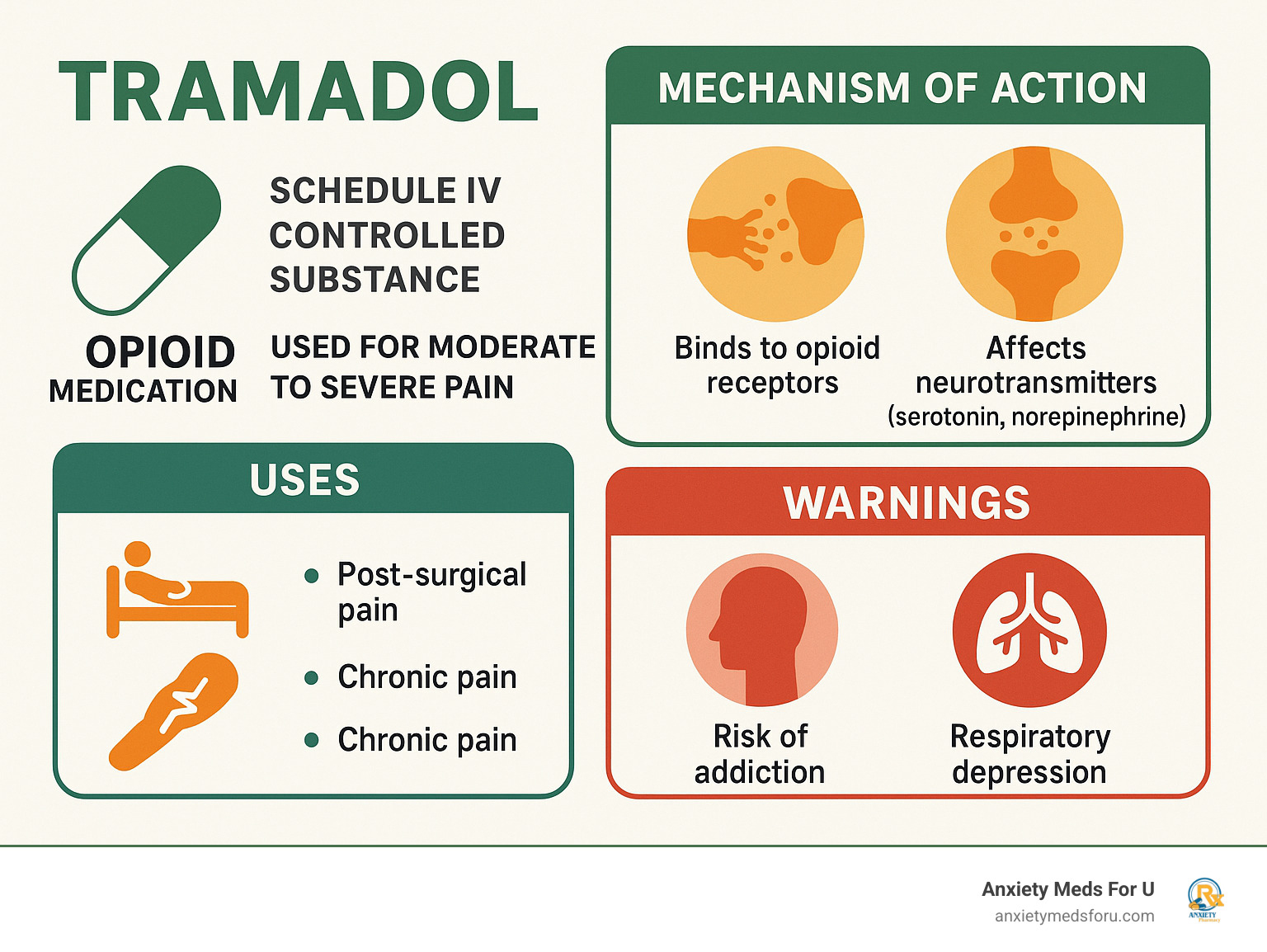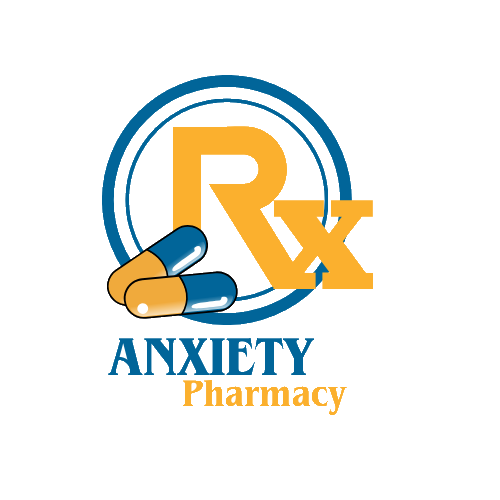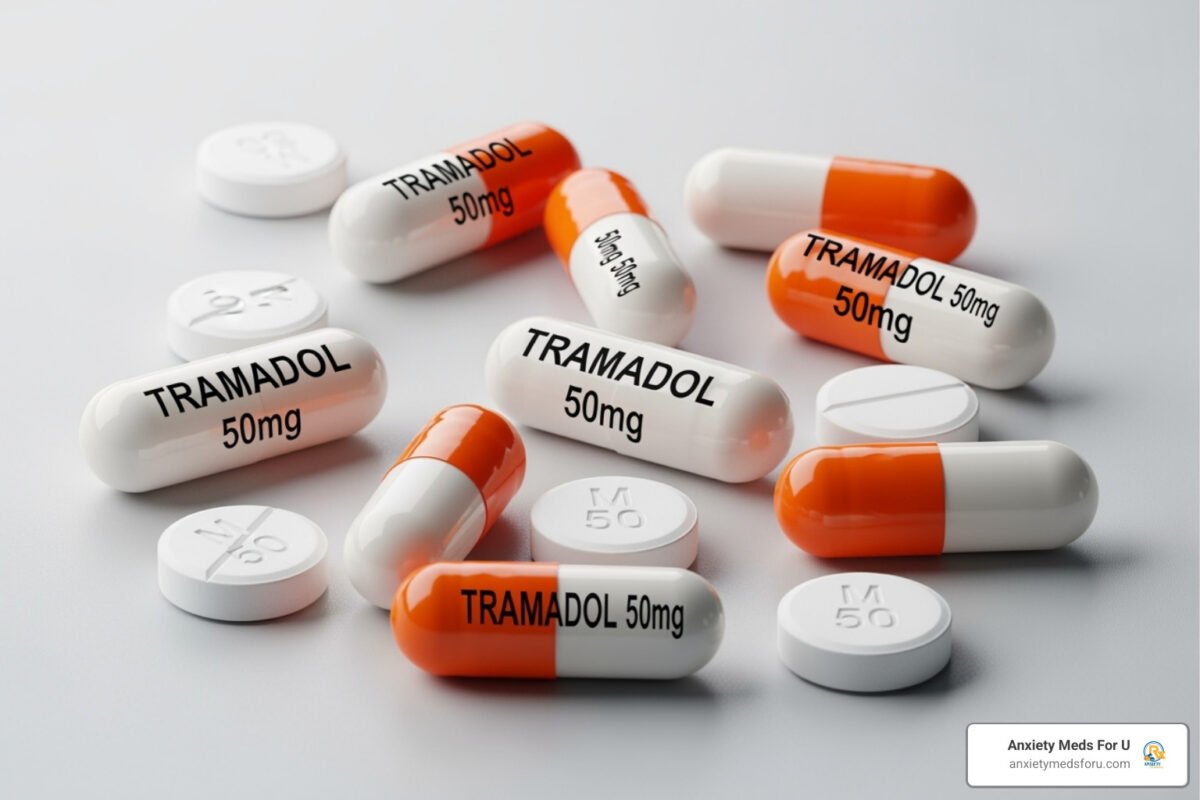Tramadol’s Purpose: A Deep Dive into Its Medical Applications

Understanding Tramadol’s Role in Modern Pain Management
What is tramadol used for? This is a common question for those with persistent pain unresponsive to over-the-counter medications. Tramadol is a prescription opioid used for moderate to severe pain when other treatments are inadequate or not tolerated.
Primary uses of tramadol include:
- Post-operative pain: Relief after surgical procedures.
- Injury-related pain: Managing pain from serious injuries.
- Chronic pain conditions: Long-term pain from osteoarthritis or fibromyalgia.
- Cancer-related pain: Pain management for cancer patients.
- Neuropathic pain: Nerve-related pain conditions.
Tramadol has a dual mechanism of action. It binds to opioid receptors in the brain and also increases levels of serotonin and norepinephrine, which help control pain perception. This makes it effective for various pain types but also carries risks like addiction, respiratory depression, and drug interactions.
As a Schedule IV controlled substance, tramadol requires a prescription and close medical supervision due to its potential for misuse and serious side effects.

What is Tramadol and How Does It Work?
Tramadol is an opioid agonist, a strong painkiller that works with your central nervous system to manage moderate to severe pain. It’s prescribed when over-the-counter relievers are insufficient, such as after surgery, a serious injury, or for chronic pain.
What makes tramadol unique is its dual mechanism of action. First, it binds to mu-opioid receptors in the brain, interrupting pain signals. Second, it acts as a serotonin and norepinephrine reuptake inhibitor, increasing the levels of these brain chemicals that help your body naturally control pain perception. This two-fold approach makes it effective for pain that doesn’t respond to traditional opioids alone.
Due to its opioid properties and potential for misuse, tramadol was classified as a Schedule IV controlled substance in 2014. The DEA recognized that while it may seem milder than other opioids, it carries real risks of dependence. This reclassification led to stricter prescription monitoring and highlights the importance of medical supervision when using tramadol. A valid prescription is required to Buy Tramadol Online, ensuring it is used safely and appropriately. For more details, you can review Scientific research on Tramadol’s pharmacology.
What is Tramadol Used For? A Guide to Its Applications

Tramadol bridges the gap between weaker pain relievers and stronger opioids. It’s prescribed for moderate to severe pain when medications like ibuprofen or acetaminophen are not effective enough.
Managing Moderate to Severe Acute Pain
For sudden, intense pain, tramadol is a valuable short-term treatment. Common uses include:
- Post-operative pain: After surgery, tramadol helps manage severe pain, allowing for better rest and recovery.
- Post-injury pain: It provides fast-acting relief for pain from accidents, fractures, or serious sprains.
- Dental pain: For pain from complex procedures or severe infections, tramadol offers stronger relief than standard medications.
In these acute situations, tramadol is intended for short-term treatment to get you through the most painful period of healing.
What is tramadol used for in chronic conditions?
Using tramadol for chronic pain is more complex and is considered only when non-opioid treatments have failed. It may be part of a broader pain management plan for:
- Osteoarthritis: When joint deterioration causes constant pain that other treatments can’t manage.
- Fibromyalgia: Its dual action on pain receptors and brain chemicals can be effective for the widespread muscle pain of this condition.
- Neuropathic pain: Tramadol’s effect on serotonin and norepinephrine can help with nerve pain from conditions like diabetic neuropathy, where other painkillers often fail.
Tramadol is not a first-line treatment for chronic pain; it’s an option when other approaches are insufficient.
What is tramadol used for in off-label scenarios?
Doctors may prescribe tramadol for conditions not officially approved by the FDA, known as off-label prescribing. This is based on clinical experience and requires careful doctor’s discretion. Examples include:
- Premature ejaculation: Tramadol’s effect on serotonin may help delay ejaculation.
- Restless legs syndrome: Some patients find relief from the uncomfortable urge to move their legs.
Any off-label use requires a thorough discussion with your healthcare provider about the potential benefits and risks.
Available Forms, Strengths, and Proper Dosage

Tramadol is available in several forms and strengths, allowing doctors to tailor treatment to your specific pain needs.
Common Strengths and Formulations
- Immediate-release (IR) tablets: These act quickly (within 30-60 minutes) for acute or breakthrough pain. Common strengths are Tramadol 50mg and Tramadol 100mg, typically taken every 4-6 hours.
- Extended-release (ER) formulations: These tablets and capsules release medication slowly for steady, around-the-clock pain relief. Tramadol 200mg and 300mg strengths are common for chronic pain.
- Oral solution: A liquid form for those who have difficulty swallowing pills, allowing for precise dosing.
- Combination products: Tramadol is sometimes combined with acetaminophen (e.g., Ultracet). If taking these, do not take extra acetaminophen to avoid overdose.
Dosage Guidelines and Administration
Always take tramadol exactly as prescribed. Your dosage depends on your pain severity, age, health conditions, and response to the medication.
- For IR tramadol: The usual starting dose is 50-100mg every 4-6 hours, not to exceed 400mg per day.
- For ER tramadol: Typically started at 100mg once daily, with a maximum of 300mg daily. Swallow ER tablets whole. Never crush, chew, or dissolve them, as this can cause a fatal overdose.
If you miss a dose of IR tramadol, take it as soon as you remember, unless it’s nearly time for the next one. Never double the dose.
Overdose is a medical emergency. Symptoms include severe drowsiness, pinpoint pupils, slow or stopped breathing, seizures, and loss of consciousness. Call emergency services or use the Poison Control online tool immediately. Naloxone can reverse a tramadol overdose, and having it available is a wise precaution.
Understanding the Risks and Side Effects
While tramadol is effective for pain, it’s crucial to understand its risks and side effects. Being aware of these issues empowers you to use the medication safely.
Common Side Effects
Many side effects are most common when starting tramadol and often lessen over time. These include:
- Nausea and vomiting (taking with food may help)
- Constipation
- Dizziness and drowsiness (avoid driving until you know how it affects you)
- Headache
- Dry mouth and sweating
If these side effects are severe or persistent, talk to your doctor.
Serious Warnings and Precautions
Tramadol carries serious risks that require careful medical supervision.
- Addiction and Dependence: Physical dependence can occur even when taken as prescribed. Addiction is a risk involving compulsive use despite harm. See the Guidance on opioid addiction risk for more information.
- Respiratory Depression: Dangerously slowed or stopped breathing is the most life-threatening risk, especially when starting treatment or increasing the dose.
- Seizures: Seizures can occur even at normal doses, with increased risk at higher doses or with certain medical conditions.
- Serotonin Syndrome: A potentially fatal condition caused by high serotonin levels, often from mixing tramadol with other drugs like antidepressants. Symptoms include confusion, rapid heart rate, and high fever.
- Withdrawal: Stopping tramadol abruptly can cause withdrawal symptoms like anxiety and muscle aches. Your doctor will help you taper off the dose gradually.
Key Drug and Substance Interactions
Tramadol can interact dangerously with other substances. Always inform your doctor of all medications and supplements you take.
- Alcohol: Combining with alcohol is extremely dangerous and can lead to fatal respiratory depression.
- Benzodiazepines and other CNS Depressants: Mixing with drugs like Xanax, Valium, other opioids, or sedatives greatly increases the risk of overdose.
- Antidepressants: MAOIs are a dangerous combination. SSRIs and SNRIs also increase the risk of serotonin syndrome and require careful monitoring.
Safe Use, Storage, and Alternatives
Responsible use of tramadol is a partnership between you and your doctor. Following their guidance is key to achieving pain relief safely.
How to Use Tramadol Safely
- Follow your prescription exactly. Never take more, more often, or for longer than directed.
- Avoid driving or operating machinery until you know how tramadol affects you, as it can cause drowsiness and dizziness.
- Inform your doctor of all health conditions, especially any history of seizures, kidney or liver disease, breathing problems, or substance abuse.
- Use with caution during pregnancy and breastfeeding. Tramadol is generally not recommended as it can harm the baby. The FDA advises against its use while breastfeeding.
- Tramadol is not for children under 12 and its extended-release form is not for those under 18.
Proper Storage and Disposal
- Store tramadol at room temperature, away from heat and moisture, in a secure location like a locked cabinet, out of reach of children and pets.
- Dispose of unused medication safely. Use a medicine take-back program if available. Otherwise, mix the medication with an undesirable substance (like coffee grounds), seal it in a bag, and throw it in the trash. For more information, see guidelines on the safe disposal of unwanted medicines.
Alternatives for Pain Management
Tramadol is just one option. A comprehensive pain management plan may include:
- Non-opioid medications: Acetaminophen, NSAIDs (ibuprofen, naproxen), and certain antidepressants or anticonvulsants.
- Physical therapies: Physical therapy, exercise, acupuncture, and massage.
- Mind-body techniques: Meditation, deep breathing, and yoga can alter pain perception.
- Lifestyle changes: Pacing activities, improving sleep, and managing stress are crucial for controlling chronic pain.
Frequently Asked Questions about Tramadol
Here are answers to some common questions about tramadol.
Is tramadol a strong painkiller?
Yes, tramadol is a strong, prescription-only opioid analgesic used for moderate to moderately severe pain. While not as potent as opioids like morphine, its unique dual-action mechanism makes it very effective, especially for nerve-related pain. Its strength is why it’s a Schedule IV controlled substance.
Can you drink alcohol while taking tramadol?
No. Mixing alcohol with tramadol is extremely dangerous. Both substances depress the central nervous system, and combining them can lead to severe drowsiness, respiratory depression (slowed or stopped breathing), coma, and death. Avoid alcohol entirely while taking this medication.
How long does it take for tramadol to start working?
This depends on the form:
- Immediate-release (IR) tramadol typically starts working within 30 to 60 minutes, with effects lasting 4 to 6 hours. It’s used for acute or breakthrough pain.
- Extended-release (ER) tramadol releases medication slowly over 12 to 24 hours. It’s not for immediate relief but for providing steady, around-the-clock pain control for chronic conditions.
Conclusion
We’ve explored what is tramadol used for, highlighting its role in managing moderate to severe pain through a unique dual-action mechanism. It is effective for post-surgical, injury-related, and chronic pain, such as from osteoarthritis or fibromyalgia.
However, its benefits come with significant risks, including addiction, respiratory depression, and seizures. As a Schedule IV controlled substance, tramadol requires careful medical supervision and strict adherence to your prescription to ensure safety.
Always discuss your health history and pain management needs with your healthcare provider to determine if tramadol is the right choice for you. Effective pain management is a collaborative effort between you and your medical team.
For those seeking affordable pain management solutions, Anxiety Meds For U offers discreet, fast delivery and significant savings on a range of medications. We are committed to making treatment more accessible while emphasizing the importance of professional medical guidance.
Explore pain relief options and find how we can help make your pain management more affordable.














